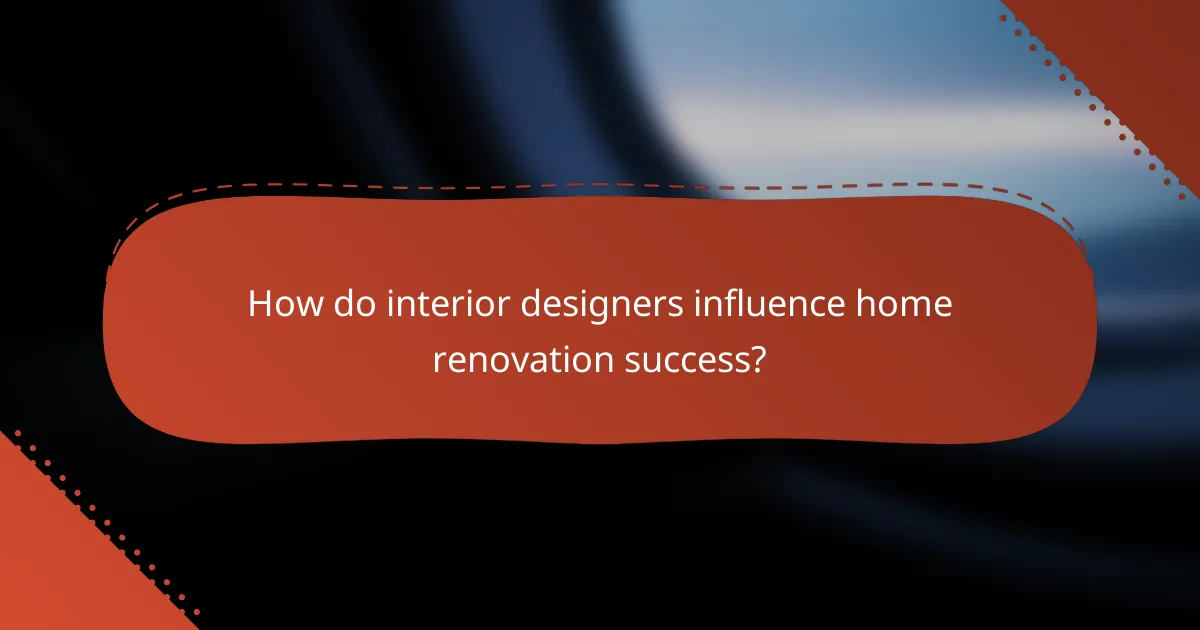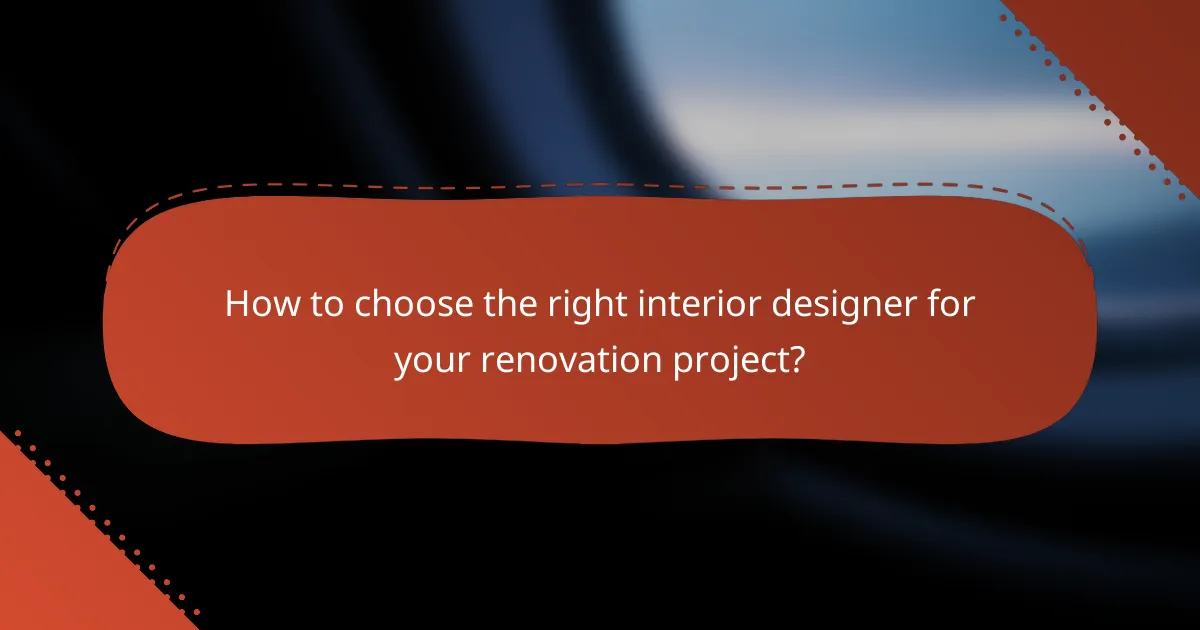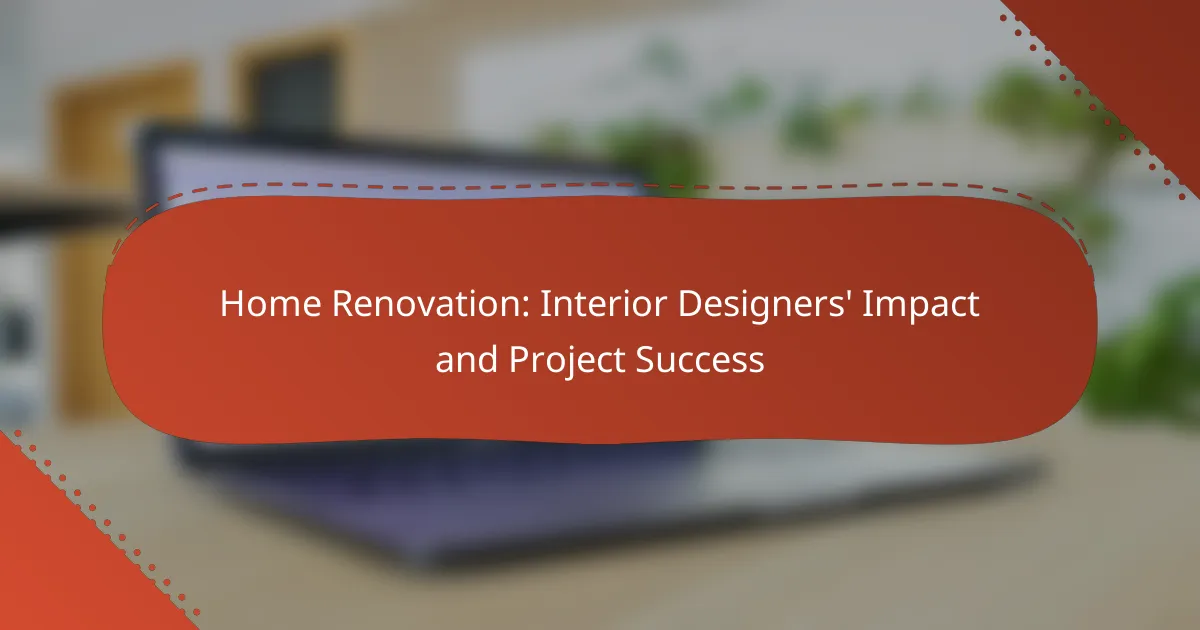Interior designers play a crucial role in the success of home renovations by blending aesthetics with functionality, ultimately enhancing property value. Their specialized knowledge helps homeowners realize their vision while navigating practical challenges, ensuring a smoother renovation process. By leveraging local resources and expertise, these professionals can significantly elevate the quality and efficiency of any renovation project.

How do interior designers influence home renovation success?
Interior designers significantly impact home renovation success by enhancing aesthetics, improving functionality, and increasing property value. Their expertise ensures that renovations meet both the homeowner’s vision and practical needs, leading to more satisfying outcomes.
Enhanced aesthetic appeal
Interior designers bring a trained eye for color, texture, and layout, which can transform a space into a visually appealing environment. They understand design principles and trends, allowing them to create cohesive looks that reflect the homeowner’s style.
By selecting appropriate materials and furnishings, designers can elevate the overall ambiance of a home. For example, using high-quality finishes and well-chosen decor can create a luxurious feel, which is often more difficult to achieve without professional guidance.
Improved functionality
Functionality is a key focus for interior designers, who assess how spaces are used and how they can be optimized. They can suggest layouts that enhance flow and accessibility, making daily activities more efficient.
For instance, in a kitchen renovation, a designer might recommend an open layout with an island for better movement and social interaction. This thoughtful approach can significantly improve how a family interacts within their home.
Increased property value
Investing in professional interior design can lead to a notable increase in property value. Homes that are well-designed and thoughtfully renovated tend to attract higher offers in the real estate market.
According to industry insights, well-executed renovations can yield returns of 70% to 90% on investment. Features like updated kitchens and bathrooms, which are often highlighted by designers, are particularly appealing to potential buyers.

What are the key benefits of hiring an interior designer in urban areas?
Hiring an interior designer in urban areas offers several advantages, including access to local resources, expertise in navigating zoning regulations, and tailored design solutions that enhance project success. These professionals can significantly streamline the renovation process while ensuring compliance with local standards.
Access to local resources
Interior designers have established relationships with local suppliers, contractors, and artisans, which can lead to better pricing and unique materials. This access allows them to source items that are not readily available to the general public, enhancing the overall quality of the renovation.
Additionally, designers often know where to find local furniture and decor that fits the urban aesthetic, making it easier to create cohesive and stylish spaces. Their familiarity with the area can also help in selecting sustainable options that support local businesses.
Expertise in zoning regulations
Urban areas often have complex zoning laws and building codes that can be challenging to navigate. Interior designers are typically well-versed in these regulations, ensuring that your renovation complies with local requirements, which can save time and prevent costly fines.
They can assist in obtaining necessary permits and approvals, streamlining the process and allowing you to focus on the creative aspects of your project. This expertise is particularly valuable in densely populated cities where regulations can vary significantly from one neighborhood to another.
Tailored design solutions
Every urban space is unique, and interior designers excel at creating tailored solutions that reflect your personal style while maximizing functionality. They can assess your needs and preferences, then develop a design that makes the most of your available space.
For instance, a designer might suggest multifunctional furniture for small apartments or innovative storage solutions that keep your living area organized. Their ability to blend aesthetics with practicality ensures that your renovation not only looks great but also meets your everyday needs.

What are the costs associated with hiring an interior designer?
The costs of hiring an interior designer can vary significantly based on their pricing structure, experience, and the scope of the project. Understanding these costs is essential for budgeting and ensuring the success of your home renovation.
Hourly rates
Many interior designers charge by the hour, with rates typically ranging from $50 to $300 per hour depending on their expertise and location. This model is beneficial for smaller projects or consultations where you only need specific advice.
When considering hourly rates, keep in mind that complex projects may require more hours, leading to higher overall costs. Always ask for an estimate of the total hours expected to avoid surprises.
Flat fees
Some designers offer a flat fee for their services, which can simplify budgeting. Flat fees can range from a few hundred to several thousand dollars, depending on the project’s complexity and the designer’s reputation.
This pricing model is often used for comprehensive services, including design, sourcing materials, and project management. Ensure you clarify what is included in the flat fee to avoid additional costs later.
Percentage of project cost
Another common pricing method is charging a percentage of the total project cost, typically between 10% and 20%. This approach aligns the designer’s compensation with the overall budget, incentivizing them to manage costs effectively.
When using this model, be aware that the total cost can increase if your project scope expands. Discuss potential budget changes upfront to maintain clarity throughout the renovation process.

How to choose the right interior designer for your renovation project?
Choosing the right interior designer is crucial for the success of your renovation project. Look for someone whose style aligns with your vision, has a solid track record, and communicates effectively.
Evaluate portfolios
Start by examining the portfolios of potential interior designers. A strong portfolio showcases a variety of completed projects that reflect their design style and capabilities. Look for projects similar to yours in scope and aesthetic to gauge their suitability.
Pay attention to the details in their work, such as color schemes, furniture choices, and spatial arrangements. This will help you determine if their design philosophy resonates with your personal taste.
Check client reviews
Client reviews provide valuable insights into an interior designer’s reliability and professionalism. Look for feedback on platforms like Google, Houzz, or Yelp to see how previous clients rate their experiences.
Focus on comments regarding communication, adherence to budgets, and project timelines. A designer with consistently positive reviews is likely to be a safer choice for your renovation.
Assess communication style
Effective communication is essential for a successful renovation project. Assess how potential designers interact with you during initial consultations. Do they listen to your ideas and provide constructive feedback?
Consider whether their communication style matches your preferences. If you prefer detailed updates and frequent check-ins, ensure the designer is willing to accommodate that approach to keep you informed throughout the project.

What are the common challenges in home renovation projects?
Home renovation projects often face several challenges that can impact their success, including budget overruns, timeline delays, and design misalignment. Understanding these issues can help homeowners navigate their renovation journey more effectively.
Budget overruns
Budget overruns are a frequent challenge in home renovations, often resulting from unexpected costs or poor initial estimates. Homeowners should prepare for a contingency fund, typically around 10-20% of the total budget, to cover unforeseen expenses.
Common causes of budget overruns include changes in design, material price fluctuations, and hidden structural issues. To mitigate these risks, it’s essential to have a detailed budget plan and to communicate regularly with contractors about potential cost changes.
Timeline delays
Timeline delays can significantly disrupt renovation projects, often caused by factors such as contractor availability, supply chain issues, or weather conditions. Homeowners should expect that renovations may take longer than initially planned and build flexibility into their schedules.
To minimize delays, establish a clear timeline with contractors and set realistic deadlines. Regular check-ins can help ensure that the project stays on track and that any issues are addressed promptly.
Design misalignment
Design misalignment occurs when the final outcome does not match the homeowner’s vision or functional needs. This can happen due to miscommunication with designers or contractors, leading to dissatisfaction with the finished space.
To avoid design misalignment, homeowners should invest time in the planning phase, clearly articulating their preferences and requirements. Utilizing 3D modeling tools or mood boards can help visualize the design and ensure alignment before construction begins.

How can homeowners collaborate effectively with interior designers?
Homeowners can collaborate effectively with interior designers by establishing clear communication and setting mutual expectations from the outset. This partnership hinges on sharing ideas, preferences, and budgets to ensure the project aligns with the homeowner’s vision.
Establish clear goals and expectations
Before starting a project, homeowners should outline their goals and expectations regarding style, functionality, and budget. This clarity helps interior designers understand the homeowner’s vision and tailor their approach accordingly. Consider creating a mood board or compiling images that reflect your desired aesthetic.
Maintain open communication
Regular communication is crucial throughout the renovation process. Schedule consistent check-ins to discuss progress, address concerns, and make necessary adjustments. Utilize tools like project management apps or shared documents to keep everyone on the same page.
Be receptive to professional advice
While homeowners should express their preferences, being open to the designer’s expertise can enhance the project’s outcome. Designers often have insights into materials, layouts, and trends that can elevate the final result. Trusting their judgment can lead to innovative solutions that align with your vision.
Set a realistic budget
Establishing a budget early on helps prevent misunderstandings later. Be transparent about financial constraints and discuss potential costs for materials, labor, and unexpected expenses. A good rule of thumb is to allocate an additional 10-20% of your budget for contingencies.
Provide timely feedback
Timely feedback on design proposals and progress helps keep the project on track. If you have concerns or suggestions, communicate them promptly to avoid delays. Constructive feedback fosters a collaborative atmosphere and ensures the final design meets your expectations.
